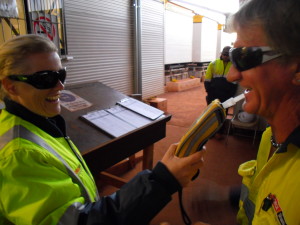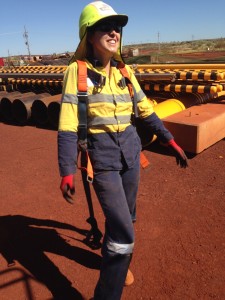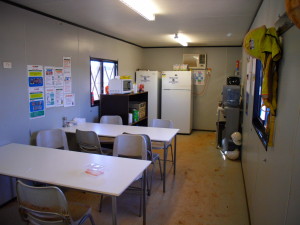The sound of flip flops slapping against concrete and beer bottles clinking as they’re tossed into trash cans at sunrise will forever be the soundtrack to my six months of living in the Pilbara.

The infamous Pilbara (said Pill-bruh). While I feel I basically lived “up north,” the city where I received my mail (Perth) is also highlighted here.
I spent about 140 of the aforementioned 180 days living in a shipping container divided into four minuscule hotel rooms and working 84 hours a week in 100+ degree heat. (That’s 40+ for those of you who speak Celsius.)
Every day I donned a heavy-duty, long sleeved shirt ringed in reflective bands; long, dark work pants; steel toed boots with thick wool socks; a bucketload of sunscreen; and a hard hat. Everything I ate came from the camp’s cafeteria (called the “dry mess” – as opposed to the “wet mess” where alcoholic beverages are sold to and consumed by the camp’s inhabitants).
The melodic alarm tone from my phone rung out as early as 3:30 each morning. After a workout, I’d pack my “crib” (lunch for the day) in single-use plastic containers. The bus to “site” – about four miles down the road from camp — left at 5:30.
Before the clock struck 6 a.m. I took a breathalyzer test to prove I was “fit for work,” made a cup of instant coffee or tea, and squeezed my plastic bag full of plastic food containers into a fridge in “Crib Room 1” – one of four portable, air-conditioned trailers containing tables and chairs for workers’ two daily breaks.

Every single employee has to take a breathalyzer test every single morning. Failing said test is called “blowing numbers” which can get you a “window seat” (fired) if you’re not friends with the right people.
The “pre-start” meeting involved management and safety representatives generally inaudibly droning on about various issues to the barely-listening workforce followed by a half-baked attempt at getting the employees warmed up and stretched out in anticipation of the day’s physical demands. We then broke into our separate divisions, and middle-management (our direct supervisors) divvied up the days tasks.
Somewhere between 9:30 and 10:30, in half-hour rotations, we’d trickle from the field into the crib rooms and back out — scarfing down a few tubs of the food we’d packed ourselves and mindlessly scrolling our smart-phone screens (present company excepted — I have successfully avoided smart phone ownership thus far).
After another four hours under the baking sun, heat radiating off the omnipresent metal objects that dominate industrial construction and the ground which is literally made of metal (we were building facilities for an iron-ore mine), we headed back into the crib rooms for more sustenance, air-con, chit-chat, and cell phone adoration.

A rough idea of a “camp room.” Ironically, I don’t have a photo of the (smallest, least-flash) one I stayed in the longest.
The work day ended with “de-brief” – a pow-wow led by each division’s middle management during which more than half the participants were primarily thinking about the cold beers waiting in their fridges back at camp. After we reported tasks accomplished and any injuries sustained, Operation Get-back-to-camp-as-fast-as-humanly-possible commenced.
Arrival at camp triggered a frenzy of either showering and sprinting to the cafeteria (dry mess) to address one’s rumbling stomach or sprinting to one’s fridge and cracking open a cold beer. The work schedule for remote construction is insane compared to the cultural average. Tell me who wouldn’t go crazy working 84 hours a week for four weeks straight living in a pod of buildings in the middle of the desert, then going home to your family and friends for only six full days before hitting the restart button? As such, the majority of participants in this absurd money game are alcohol aficionados.
My evenings were spent on the meager kilometers of walking loops available at camp while admiring the sunset and the unique Pilbara desert vegetation, followed by trying to pretend for a few minutes that I had a life outside of camp and work. That or hitting the gym if 3:30 a.m. had seemed ridiculous and impossible that morning. And doing that whole cafeteria dinner thing, which I originally greeted with enthusiasm but eventually avoided like the plague. An introvert at heart, after spending twelve working hours interacting with people, another 30 minutes at a dinner table was often more than I could face.
Then we’d wake up in the morning and do it all over again!
What was the actual job? I’ll save that for the next entry. ♣
A termite mound the size of a small child, seed pods that look like cockroaches, and the aftermath of my run-in with oversized bolt cutters are in this facebook album.







Wonderful post Jema!!! What wonderful pictures you take capturing the beauty of your surroundings even though it was a grueling place to work!!! Loved it!!!! Xoxo
Thanks – glad you enjoyed, Madre! I loved the Pilbara, just didn’t love the schedule.